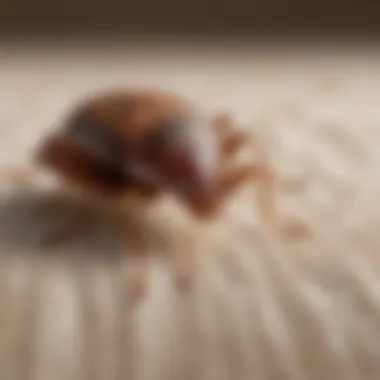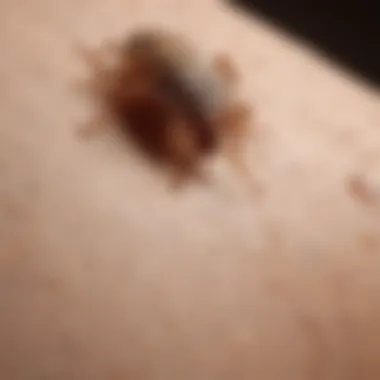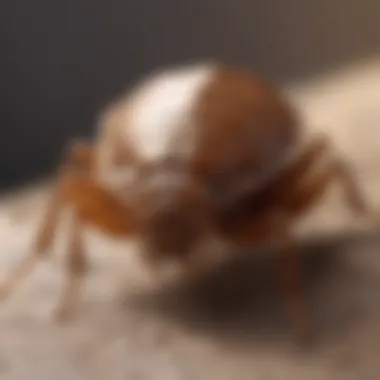Understanding Bed Bug Rashes and Itchiness


Intro
Understanding bed bug-related rashes and itchiness is crucial for those who experience these distressing symptoms. Bed bugs are tiny, parasitic insects that feed on the blood of humans and animals. Their bites can cause various skin reactions, including rashes and significant itchiness. This article aims to provide a comprehensive overview of the topic, discussing the biology of bed bugs, their bite patterns, and the allergic responses they may provoke. Additionally, we will delve into identification methods for bed bug rashes, treatment options, prevention strategies, and the psychological impact of these infestations.
With a focus on homeowners and pest management professionals, our examination seeks to clarify the complexities surrounding bed bugs and their interactions with humans, offering valuable insights for effective management and control.
Understanding Pests
Definition of Pests
Pests are organisms that negatively affect human activities, challenging our health, comfort, and safety. Bed bugs fit this category as they cause distress and health concerns through their bites. Understanding their biology and behavior is essential for effective control. These pests are nocturnal and often appear in bedding, furniture, and clothing.
Importance of Pest Identification
Identifying pests like bed bugs is critical for appropriate action. Proper identification will help distinguish them from similar insects. Misidentification can lead to incorrect treatment methods, prolonging the infestation and increasing discomfort.
Bed bugs can be identified by their flat, oval-shaped bodies and reddish-brown color. Bites often manifest in clusters, typically on exposed skin areas such as the arms and neck. These characteristics aid in distinguishing bed bug bites from those of other insects.
Prevention Techniques
Home and Garden Preventative Measures
Preventing bed bug infestations begins at home. Regular cleaning routines are crucial. Here are some effective measures:
- Use protective covers: Encase mattresses and box springs in bed bug-proof covers. This limits their access and makes it harder for them to infest sleeping areas.
- Declutter: Keep living spaces free from unnecessary items. Clutter provides hiding spots for bed bugs.
- Regular vacuuming: Vacuum carpets, furniture, and baseboards regularly. Empty the vacuum immediately to avoid re-infestation.
- Inspect second-hand items: When purchasing second-hand furniture or clothing, inspect and treat it before bringing it into your home.
Seasonal Prevention Tips
Certain seasons may increase bed bug activity. Here are tips for particular times of the year:
- Spring and Summer: Conduct thorough inspections during warmer months. Bed bugs may spread as people travel and share locations.
- Fall and Winter: Monitor for signs when returning home from vacation. Use heat treatments for luggage before entering your home.
Eco-Friendly Pest Control Solutions
Overview of Sustainable Practices
Adopting eco-friendly pest control methods can be effective in managing bed bugs while minimizing environmental impacts. Integrated pest management (IPM) combines preventive measures, monitoring, and non-chemical solutions. Combining various approaches leads to more sustainable practices.
Natural Remedies and Their Effectiveness
Many natural remedies claim to help with bed bug control. While some may provide temporary relief, they are not always reliable. Examples include:
- Diatomaceous Earth: This powder can dehydrate and kill bed bugs upon contact. It must be applied correctly to be effective.
- Essential Oils: Some oils, such as tea tree oil and lavender, are thought to repel bed bugs. However, their effectiveness varies and may not be a comprehensive solution.
While natural remedies may complement other control methods, consulting professionals for severe infestations is advisable.
"Proactive monitoring and prompt identification are key to preventing bed bug-related rashes and itchiness."
Foreword to Bed Bugs
Bed bugs have become a common concern in many households today. Understanding their nature is crucial for effective management and prevention of infestations. In this section, we will explore key attributes of bed bugs, including their biology, habits, and the implications they have on human health. This knowledge lays the groundwork for recognizing signs of bed bug presence and the need for proper action plans.
Understanding Bed Bugs: Biology and Behavior
Bed bugs, scientifically known as Cimex lectularius, are small, parasitic insects that feed on human blood. Their biological structure is adapted for their feeding habits. Adult bed bugs can grow to about 5 to 7 mm in length, resembling apple seeds. They are reddish-brown in color.


Bed bugs are nocturnal and prefer to hide during the day in cracks and crevices. Their behavior of seeking hosts at night makes them especially hard to detect until after bites occur. They can travel easily from place to place, often hitching rides on luggage or clothing. Their preferred environment is warm, which is why they are commonly found in homes, hotels, and other lodgings where humans reside.
Understanding the behavior of bed bugs is essential for both residents and pest control professionals. Effective management requires a clear comprehension of how these pests operate.
The Lifecycle of Bed Bugs
The lifecycle of bed bugs undergoes several stages: egg, nymph, and adult.
- Egg Stage: Female bed bugs lay eggs in secluded areas, often in clusters. These eggs are tiny, about 1 mm, and are often hidden in crevices and seams of mattresses.
- Nymph Stage: Once the eggs hatch, the young, called nymphs, emerge. They are smaller in size and translucent. Nymphs will molt multiple times before reaching adulthood, needing a blood meal to grow at each stage.
- Adult Stage: After five molts, nymphs become adults. Adult bed bugs can live for many months without feeding, making them resilient. They can reproduce quickly, with females laying several eggs each day.
The entire lifecycle from egg to adult can take a few weeks to several months, depending on environmental conditions like temperature and humidity. This rapid development highlights the need for prompt action when signs of infestation are detected.
Understanding the lifecycle of bed bugs can help in developing effective pest management strategies. The faster the life cycle, the quicker infestations can grow.
In summary, recognizing the biology and behavior of bed bugs is vital for homeowners concerned about potential infestations. It also aids in understanding why treatment procedures need to be thorough and multifaceted.
Identifying Bed Bug Bites
Identifying bed bug bites is a crucial aspect of managing both infestations and the health impacts associated with them. Many individuals may not realize they have been bitten until the subsequent reactions appear. Recognizing the specific bites early on can aid in timely intervention, reducing discomfort and minimizing further exposure to these pests. Understanding the nature of the bites is not only important for immediate relief but also for long-term preventive measures, leading to healthy living environments.
Characteristics of Bed Bug Bites
Bed bug bites typically present as small, red, itchy welts that may resemble those caused by other insects. However, their unique characteristics can help in identifying them distinctly. For instance, bites may appear in clusters or a linear formation, often along areas that are exposed during sleep. This pattern occurs due to the bug's feeding habits, as they tend to bite multiple times in one area before moving on. The bites generally do not occur randomly but follow a discernible pattern.
Some notable characteristics include:
- Color: Bites usually appear red, influenced by the inflammatory response of the skin.
- Size: They often appear as small, raised bumps.
- Shape: In some cases, they may develop into more prominent hives.
- Time of Appearance: Many individuals notice bites after a lapse of several days, complicating the association with an infestation.
Using this knowledge for identification can prompt beneficial actions, like thorough inspections of sleeping areas and potential pest control measures.
Common Reactions to Bed Bug Bites
The human body's response to bed bug bites varies widely among individuals. Allergic reactions range from mild to severe, influenced by factors like sensitivity and exposure frequency. Common reactions can include:
- Mild Itching: For many, the most immediate concern is itchiness, which can lead to scratching and subsequent skin irritation.
- Swelling: The area around the bite often becomes swollen, which may be accompanied by redness.
- Severe Allergic Reactions: In rare cases, individuals might experience anaphylactic reactions that demand immediate medical attention.
Additionally, secondary infections can occur if scratching leads to open wounds. Being aware of these reactions can guide individuals toward appropriate remedies or treatments, significantly improving quality of life and comfort.
Bed Bug Rash: What to Look For
Understanding the rashes associated with bed bug bites is crucial for anyone experiencing discomfort after suspected encounters with these pests. Awareness of the types of rashes and their characteristics helps in identifying bed bug infestations effectively. This section delves into the various types of rashes that can occur, the different skin reactions individuals may exhibit, and their significance in managing discomfort and informing effective treatment options.
Types of Rashes Associated with Bed Bug Bites
Inflammatory Rash
An inflammatory rash is one of the primary reactions to bed bug bites. This type of rash occurs due to the body's immune response to the saliva injected by the bed bug when it bites. The main characteristic of an inflammatory rash is its redness and swelling around the bite area. This rash is often itchy, signaling a heightened reaction from the immune system. Its relevance in the article lies in the need for quick identification to manage itchiness effectively.
A distinct feature of inflammatory rashes includes their potential to lead to further irritation if scratched. This scratching can result in additional complications, such as secondary infections, making it essential for individuals to recognize this rash early. Understanding inflammatory rashes can provide insight into immediate strategies for alleviating discomfort.
Allergic Rash
Allergic rashes can arise from a more significant response to bed bug bites, especially in sensitive individuals. This rash is characterized by hives, welts, or extensive areas of redness extending beyond the bite sites. Recognizing an allergic rash is important because it may indicate a severe allergic reaction that requires urgent care.
A unique aspect of allergic rashes is their variance in severity. While some may experience mild reactions, others could face significant discomfort and may require antihistamines or topical corticosteroids for relief. Acknowledging the possibility of an allergic rash offers readers critical information about when to seek medical attention.
Secondary Infections


Secondary infections arise when initial rashes become irritated or infected due to scratching or poor hygiene practices. This aspect is vital in understanding the complications that can follow bed bug bites. Characteristics include increased redness, swelling, and sometimes pus in the affected area. It is crucial because these infections can lead to more severe health issues.
One benefit of discussing secondary infections is providing readers with preventative measures. Proper hygiene, avoiding scratching, and treating rashes can minimize the risk of such infections. Awareness of secondary infections also emphasizes the importance of monitoring bed bug bites, thus promoting better overall skin health during infestations.
Different Skin Reactions Across Individuals
It is important to acknowledge that skin reactions can vary widely among individuals experiencing bed bug bites. Factors such as skin type, immune response, and previous exposure to bites contribute to these differences. This variability can affect the severity and presentation of rashes, making it essential for individuals to assess their reactions critically.
Individual responses can differ significantly, which is why understanding personal reactions is key to managing discomfort effectively.
For example, some individuals may experience mild redness and slight itching, while others can develop severe rashes and intense itchiness. Knowledge about these differences can guide individuals in seeking appropriate treatment and offer insights into their susceptibility to bed bug bites. Awareness can also shape personalized strategies towards prevention and control measures.
The Itch: Understanding the Sensation
The experience of itching due to bed bug bites is more than just a mere annoyance; it represents a complex interaction between the body’s immune system and the allergens carried by these insects. Understanding the sensation of itchiness is fundamental in grasping how one's body reacts and what steps can be taken to alleviate discomfort. Itchiness can provoke stress and anxiety, especially in individuals dealing with bed bug infestations. Therefore, a detailed understanding of this sensation helps in managing both the physical and psychological ramifications of bed bug exposure.
The Biological Mechanisms Behind Itching
The sensation of itch, or pruritus, occurs when specific nerve cells in the skin detect inflammatory mediators released by the body in response to bed bug saliva. Bed bugs introduce anticoagulants and allergens during their feeding process. This triggers an immune response that results in the release of histamines, which are responsible for the itching sensation. When histamines bind to receptors in the skin, they create an urge to scratch.
The body’s reaction to these bites varies widely among individuals. Some may experience mild scratching, while others could have severe reactions leading to extensive inflammation. It is also important to note that repeated scratching can lead to further irritation and possible secondary infections, complicating an otherwise mild reaction.
Coping with Itchiness: Remedies and Treatments
Over-the-Counter Treatments
Over-the-counter treatments are often the first line of defense when dealing with itchiness from bed bug bites. These products typically include antihistamines and topical steroids which work effective in reducing inflammation and discomfort. Antihistamines block the action of histamines in the body, providing quick relief from itching. These are available in both oral and topical forms.
The key characteristic of these treatments is their accessibility. They do not require a prescription and can be found in most drugstores. However, while they can provide relief, overuse of topical corticosteroids may thin the skin over time, making it crucial to follow usage guidelines.
Home Remedies
Home remedies offer a natural alternative for managing itchiness from bed bug bites. Common solutions include applying aloe vera, oatmeal baths, or cold compresses. These remedies aim to soothe skin irritation without the use of chemical products.
Their simplicity and effectiveness contribute to their popularity. Many household items possess anti-inflammatory and calming properties that can provide immediate relief. For some, relying exclusively on home remedies may fall short if the itchiness is severe, indicating a need for more conventional treatments.
When to See a Doctor
Recognizing when to seek medical attention is vital in managing itchiness effectively. Consulting a healthcare professional is recommended if an individual exhibits severe symptoms such as swollen hives, prolonged itchiness, or signs of infection, like pus or fever.
The unique feature of this step is its potential to prevent worsening conditions. Early intervention may mitigate further complications that could arise if secondary infections develop. A healthcare provider can offer more potent prescription treatments or allergy testing to determine underlying sensitivities.
It is imperative for individuals experiencing persistent itching or severe allergic reactions to prioritize their health by consulting a medical professional sooner rather than later.
Understanding the myriad approaches to coping with the itch from bed bug bites equips individuals with the tools necessary for effective management and fosters a proactive stance towards their health.
Prevention and Control of Bed Bug Infestations
The prevention and control of bed bug infestations is crucial for maintaining a safe and comfortable living environment. Addressing this topic helps residents to be proactive in avoiding potential outbreaks. An ounce of prevention is worth a pound of cure, especially with pest-related issues that can create significant distress. In this section, we explore various strategies for identifying sources of infestation and implementing effective pest control measures.
Identifying Potential Infestation Sources
Understanding where bed bugs might enter a home is essential in preventing infestations. They are known for their ability to hide in tiny crevices and travel through various means. Recognizing these sources can diminish the likelihood of an infestation.
- Travel Luggage: Hotel rooms can be breeding grounds for bed bugs. Inspect luggage before bringing it inside your home.
- Second-hand Furniture: Used items can harbor pests. Thoroughly check and clean furnishings before use.
- Shared Living Spaces: Apartments and dormitories are susceptible to bed bugs moving between units. Keeping common areas clean is essential.
By being vigilant about these sources, individuals can significantly reduce their risk of an infestation.


Effective Pest Control Strategies
Professional Extermination
Professionals have the expertise in managing bed bug infestations. Their approach often includes several steps like a thorough inspection, treatment, and follow-up to ensure effectiveness.
One key characteristic of professional extermination is the use of advanced methods and tools not available to the average homeowner. Options include heat treatment, which involves raising the temperature of affected areas to a level that is lethal to bugs. This is a beneficial choice because it can eradicate all life stages of bed bugs in one go, making it highly effective.
However, the cost can be a disadvantage for some homeowners. The investment is worth considering given the potential damage and stress caused by a bed bug infestation.
DIY Methods
DIY methods for controlling bed bugs may appeal to budget-conscious homeowners. These methods include vacuuming, using steam cleaners, and applying diatomaceous earth. These techniques can be effective in managing minor infestations when executed correctly.
A key characteristic of DIY methods is accessibility; many supplies can be found in a local store or even at home. They provide a way for individuals to respond rapidly to suspected infestations, offering immediacy that might be lacking when waiting for professional help.
However, the significant disadvantage of DIY methods is that they often require persistent effort and can only address minor infestations. If the problem becomes severe, professional assistance may be necessary.
In summary, being proactive in preventing bed bug infestations relies heavily on recognizing potential sources and utilizing effective pest control strategies whether through professionals or DIY methods. Understanding the options and their respective advantages and disadvantages will equip homeowners to better protect their living spaces.
Psychological Effects of Bed Bug Infestations
Bed bug infestations can have significant emotional and psychological repercussions for individuals affected. Understanding these effects is crucial as they often extend beyond the physical discomfort caused by bites. The anxiety and distress related to a bed bug infestation can dominate daily life, influencing mental well-being and overall quality of life.
Individuals may experience heightened emotional stress due to the fear of recurrence, sleep disturbance, and stigma associated with infestations. The feeling of invasion into one's personal space can lead to feelings of vulnerability and helplessness. Notably, the stigma often leads to isolation, causing affected individuals to withdraw from social interactions, further exacerbating mental health issues.
Research indicates that psychological symptoms can include anxiety, depression, and even post-traumatic stress disorder in severe cases. The impact is particularly pronounced among children and those with pre-existing mental health conditions. Given these considerations, addressing the psychological ramifications of bed bug infestations is not merely an add-on to the management of physical symptoms; it is an integral component of a comprehensive approach to dealing with an infestation.
"The impact of bed bugs is not just physical; it's psychological. Addressing mental health in these contexts is essential for recovery."
The Impact of Infestations on Mental Health
The mental health implications of bed bug infestations can be profound. Individuals may endure sleepless nights due to the anxiety of being bitten, which can lead to chronic fatigue and decreased productivity. This lack of rest compounds feelings of irritability and stress.
Moreover, the infestation often disrupts daily routines. Tasks become overwhelming when thoughts are consumed by concern for bed bugs.
Individuals may also experience:
- Fear of Infestation: Persistent worry about the potential for re-infestation can hinder individuals from enjoying their living spaces.
- Social Anxiety: Fear of judgment or stigma from others can lead to avoidance of social settings, intensifying feelings of loneliness.
- Obsessive Thoughts: Some individuals may develop an obsessive focus on cleaning and inspecting their environment, ultimately creating a cycle of anxiety.
Coping Strategies for Affected Individuals
Finding effective coping strategies is essential for individuals facing bed bug infestations. Addressing both practical and psychological needs can facilitate recovery and restore a sense of normalcy. Some strategies include:
- Education: Learning about bed bugs, their behaviors, and treatment options can empower individuals, reducing feelings of helplessness.
- Seeking Support: Joining groups online, such as forums on reddit.com, allows individuals to share experiences and coping strategies.
- Professional Help: Consultation with mental health professionals can provide targeted strategies to manage anxiety and address emotional distress.
- Mindfulness and Relaxation: Techniques, such as meditation, can help to alleviate stress and anxiety, fostering a sense of calm.
- Home Environment Changes: Redesigning living spaces to make them less conducive to infestations can also help restore a sense of control and security.
Taking proactive steps to handle both the physical and psychological impacts of bed bugs is vital for long-term recovery. By integrating mental health support with practical measures for infestation management, individuals can move toward regaining peace of mind in their homes.
Culmination
In this article, we have explored various aspects of bed bug rashes and the associated itchiness that can significantly impact individuals' lives. Understanding these topics is crucial, especially for homeowners and pest management professionals who encounter these pests frequently. The emphasis on recognizing the symptoms, reactions, and psychological effects is vital for an effective response to infestations.
Summary of Key Points
A comprehensive overview of bed bugs reveals several essential takeaways:
- Identification of Bites: Bed bug bites often appear in clusters and may resemble other insect bites, making accurate identification necessary.
- Rash Types: Differentiating between inflammatory rashes, allergic reactions, and secondary infections can guide appropriate treatment.
- Itch Mechanisms: The biological triggers of itchiness from bed bug bites can vary widely among individuals.
- Coping Strategies: Both preventive measures and treatment options play a critical role in managing infestations and alleviating symptoms.
- Psychological Impact: The fear and stress that can stem from bed bug infestations must not be underestimated.
Final Thoughts on Bed Bug Management
"The most effective way to deal with bed bugs is not just to react to them, but to understand their biology and behavior to prevent future infestations."
Through awareness, timely actions, and proper treatment, individuals can maintain a healthier living environment free of bed bugs and their distressing impacts.



